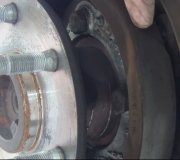There will always be two independent hydraulic circuits so you'll still have half of your brakes if there's a leak or failure in one part. There's a valve between those two circuits that normally stays centered. When a problem occurs in either circuit, fluid pressure can't build up to apply those two brakes. If the other circuit is working normally and it does build pressure, that valve trips and it turns on the switch that turns on the red warning light.
Each circuit feeds one rear brake and the opposite front one. If the rear brakes become out-of-adjustment, the pedal will have to be pushed further and further for those brakes to engage. That will affect both hydraulic circuits equally, and pressure in both circuits will be low, but as long as they're the same, that valve won't move and the light won't be turned on. That's why when you have a low pedal with no warning light, you should always start with the easy stuff. Check the rear brakes and be sure the automatic adjusters are working properly.
You can also have an internal leak in both halves of the master cylinder. It's rare for that to occur at the same time, and typically that will cause no brakes at all and the pedal will go all the way to the floor. In fact, you may still get some stopping power. The clue still would be there's no warning light turning on. If no other cause can be found for the low pedal, the master cylinder is the logical suspect.
Monday, March 29th, 2021 AT 10:52 AM


